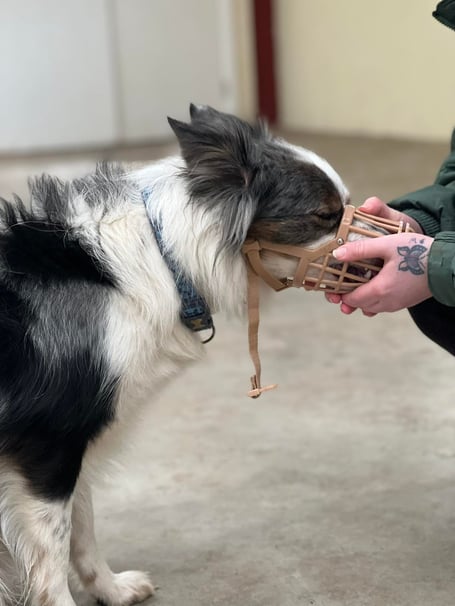In last week’s article we discussed when, and when not, it is appropriate to use a muzzle on a dog.
This week we look at the different types of muzzle and how you can encourage your dog to wear one. Remember, even if your dog does not routinely need to wear a muzzle, he or she may have to wear one in an emergency and so you should practice putting one on from time to time.
Muzzle types:
There are two main types of muzzle – the basket and the soft.
The basket muzzle looks exactly as you would expect – like a basket strapped to a dog’s nose and mouth.
They can be made of leather, plastic or rubber and can be bought in the appropriate size to fit your dog from a pet shop, or made-to-measure by a specialist firm.
The ‘prison bar’ appearance of basket muzzles makes them look like the least humane choice, but the opposite is true.
In fact, many dogs seem more comfortable in basket muzzles than in soft ones because their mouth isn’t being held closed, and most basket muzzles allow dogs to open their mouths to eat, drink and pant.
Soft muzzles are made from bendy fabric such as nylon or leather, and they wrap around a dog’s mouth and hold it closed.
They prevent a dog from panting which is the most effective way he or she has of dispersing heat – something to be very mindful of at this time of year.
In fact, soft muzzles should never be used in hot weather.
Because a dog can’t open their mouth with a soft muzzle they should only be used for very short periods of time, and for a very specific purpose.
Also, if they are used as part of a training programme, it means that you can’t reward your dog with a treat.
Some dogs readily accept a muzzle being placed on them, but others need a lot more gentle persuasion.
The first time you put a muzzle on a dog should not be the first time you need to put a muzzle on them, and most dogs will accept a muzzle if they are introduced to it in a low-stress situation.
Over a period of several days, there are a series of steps you can take to gently introduce your dog to a muzzle:
•Let them sniff the muzzle, give them a treat, and repeat a few times
•Touch their nose with the muzzle. Treat and repeat.
•Hold the treat at the end of the muzzle so that your dog has to place their nose into it to get the treat. And repeat.
•Gently slip the muzzle onto their nose, and then remove it immediately. As with all these remaining stages, keep treating and repeating a few times.
•Put on the muzzle and fasten the buckle, then remove.
•Keep doing this, and gradually increase the length of time the muzzle if left on for.
Our wonderful rescue dog, Nala, may need to wear a muzzle when she encounters dogs for the first time, because she can be nervous in strange situations.
This unease around other dogs means that Nala would prefer to be the only dog in the household.
She is five years old, is very people-orientated and her loving nature will suit someone who is able to spend a lot of time with her, helping to build her confidence.
Her previous owner died and so Nala is with us through absolutely no fault of her own.
She is a typical border collie in so many ways (she is a quick learner, she’s playful, and she’s very athletic) and we think she’s one of the prettiest collies we’ve ever seen.
If you want to meet her, please contact the kennels team (851672, option 1) and complete a home finder questionnaire which can be found on our website (www.manxspca.com)

-(1).jpeg?width=209&height=140&crop=209:145,smart&quality=75)



Comments
This article has no comments yet. Be the first to leave a comment.